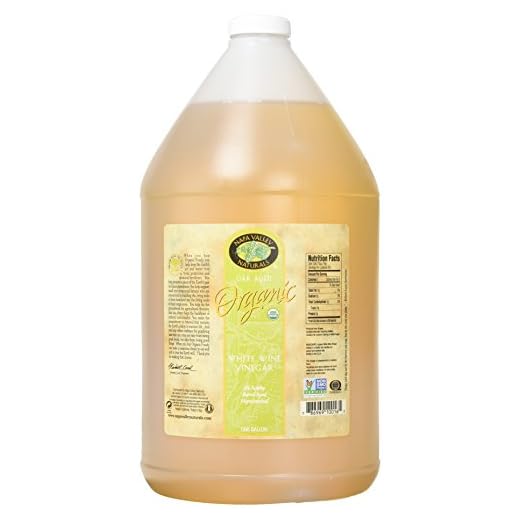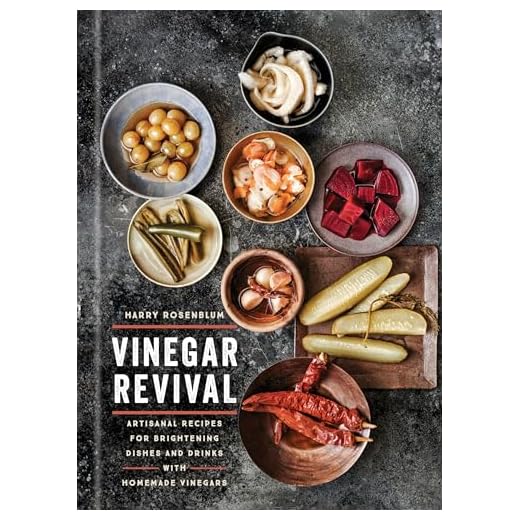

In most culinary applications, utilizing a clear acidic liquid derived from fermented grapes in place of a common distilled counterpart is feasible. Both options deliver acidity, but the nuances in flavor can result in varying outcomes. For dishes where a subtle complexity is desired, using the fermented grape option enhances the overall profile.
However, if the recipe demands a more straightforward, tart component, the distilled variant works just fine. It offers a cleaner taste without the added fruity notes. When cooking or preparing dressings, consider the desired flavor impact. For instance, in salad dressings or marinades, the rich undertones of the grape-based option can elevate the dish, while the other serves as a reliable base in pickling or preserving.
Experimenting with the two can yield delightful results. If a recipe calls for a specific type, adjust quantities based on taste preferences. Start with a smaller amount of the alternative and gradually increase until achieving the desired flavor balance. This approach ensures that the distinct characteristics of each ingredient shine through, creating a well-rounded culinary experience.
Substituting White Wine Vinegar
Opting for an alternative to regular vinegar can be a smart choice in many recipes. Using white wine vinegar in place of standard vinegar is feasible, with a few considerations in mind. The flavor profile differs slightly, offering a more nuanced taste, which may enhance certain dishes.
Flavor Considerations
White wine vinegar carries a milder and slightly sweeter flavor than its standard counterpart. This can add a depth of taste to dressings and marinades. When using it, begin with a smaller quantity and adjust according to your palate, especially in recipes where acidity is key.
Measurement Guidelines
When measuring, a direct one-to-one ratio can be a good starting point. However, keep in mind that the subtleties in taste may require fine-tuning. Here’s a quick reference table:
| Type of Vinegar | Recommended Substitution Ratio |
|---|---|
| Standard Vinegar | 1 tablespoon = 1 tablespoon of white wine vinegar |
| For Dressings | 1 tablespoon = 1 tablespoon of white wine vinegar |
| For Marinades | 1 tablespoon = 1 tablespoon of white wine vinegar |
In summary, incorporating this alternative can be a delightful twist in your culinary creations, enhancing flavors while maintaining the desired acidity. Adjusting to taste can lead to delicious results.
Flavor Differences Between White Wine Vinegar and White Vinegar
The primary distinction lies in taste. The first option offers a milder, more nuanced flavor profile with subtle fruity notes, while the alternative presents a sharper, more pronounced acidity. This difference can significantly impact the final dish, especially in dressings and marinades.
When using the fruit-based variant, expect a delicate enhancement of flavors, making it ideal for salads or light sauces. The other option, being more aggressive, works well in pickling and recipes that require a bold tang. It’s essential to consider these characteristics to achieve the desired taste in your culinary creations.
In terms of aroma, the fruity version provides a pleasant bouquet, which can elevate the overall sensory experience of a dish. Conversely, the straightforward counterpart has a clean, crisp scent that might overpower more subtle ingredients if used excessively.
Ultimately, choosing between these two acidic liquids depends on the complexity and balance sought in the dish. Adjustments in quantity may be necessary to align flavors, ensuring the final preparation meets expectations without overshadowing primary ingredients.
Common Culinary Uses for White Wine Vinegar
Incorporating this flavorful ingredient can elevate various dishes. Here are some practical applications:
- Dressings: Create vibrant salad dressings by blending it with olive oil, mustard, and herbs. The acidity adds balance and enhances flavors.
- Marinades: Use as a base for marinades to tenderize meats. Combine with garlic, herbs, and spices for a delicious infusion.
- Sauces: Add depth to sauces, particularly for poultry or fish. Deglazing pans after sautéing enhances the dish’s richness.
- Pickling: Ideal for quick pickling vegetables, providing a lighter touch compared to stronger alternatives.
- Soups: A dash can brighten the flavor profile of soups, especially tomato or bean-based varieties.
For a unique dish idea, check out this guide on how to cook lamb heart in oven.
Experimenting with this ingredient opens up new culinary possibilities, enhancing both taste and presentation in your dishes.
When to Use White Vinegar Instead of White Wine Vinegar
Choose distilled acid when a more pronounced tang is desired in recipes like pickling or cleaning solutions. Its sharper profile cuts through rich flavors, making it ideal for marinades where you want a bold punch. This option also works well in dishes that require a neutral backdrop, allowing other ingredients to shine without competing flavors.
Salad Dressings and Dips
For dressings and dips, opt for distilled acid when a straightforward acidity is needed. It enhances the freshness of ingredients without adding complexity. Use it in vinaigrettes where the primary goal is to brighten the dish without altering the flavor balance significantly.
Cooking Techniques
In high-heat cooking techniques like sautéing or frying, distilled acid can be advantageous. It withstands heat better than its wine counterpart, making it suitable for deglazing pans or adding acidity to sauces without risk of overpowering the dish’s overall flavor profile.
How to Adjust Recipes When Altering Vinegars
Start with a 1:1 ratio; however, depending on the dish, you might need to tweak the amount. For dressings, using a bit less of the replacement acidity can balance flavors better. If the recipe calls for a tablespoon, try 2-3 teaspoons initially.
Consider the flavor profile. The substitute tends to be milder, so increase herbs or spices to enhance taste. Adding a touch of sweetness, like honey or sugar, can offset sharper notes if needed.
For marinades, allow longer marination times. The different acidity levels influence how proteins absorb flavors. Adjusting marination duration can result in a more balanced dish.
In cooking, monitor heat levels. The replacement may react differently when heated. Lower temperatures can help prevent overpowering the dish’s foundation.
Finally, taste as you go. This practice is crucial. Adjusting seasoning gradually ensures the final result aligns with your expectations without overcompensating. Always remember to keep notes for future reference.
Potential Health Benefits of Each Type of Vinegar
The consumption of various types of vinegar may offer distinct health advantages. Here’s a breakdown of the potential benefits associated with these two varieties:
- Fermentation Benefits: The fermentation process in both types leads to the presence of beneficial probiotics, which can support gut health and digestion.
- Antioxidant Properties: Each variety contains antioxidants that help combat oxidative stress in the body, potentially reducing the risk of chronic diseases.
- Blood Sugar Regulation: Research suggests that certain vinegars may aid in controlling blood sugar levels after meals, making them valuable for those managing diabetes.
- Heart Health: Some studies indicate that regular consumption may help lower cholesterol levels and improve overall cardiovascular health.
- Weight Management: Incorporating these acidic liquids into meals may promote a feeling of fullness, thereby assisting in weight management efforts.
While both varieties offer potential benefits, individual responses can vary. It’s wise to consume them in moderation and consult health professionals for personalized advice.
Tips for Storing and Handling Both Vinegars
Store these liquids in a cool, dark place, away from direct sunlight and heat sources. A pantry or cupboard works well. Ensure that the cap is tightly sealed after each use to prevent oxidation and maintain flavor integrity.
Keep an eye on the shelf life: while both types can last for a long time, quality may diminish over time. If you notice any off-flavors or unusual cloudiness, it’s best to discard it.
Handling Techniques
Always use clean utensils when pouring to avoid contamination. A dedicated pour spout can help control the amount dispensed and minimize spillage. When measuring for recipes, use a precise measuring cup for accuracy.
Additional Notes
Consider labeling your bottles with the purchase date to track freshness. If you have a larger quantity, transferring to smaller bottles can help preserve flavor longer. Regularly taste-test to ensure the quality remains up to par.








